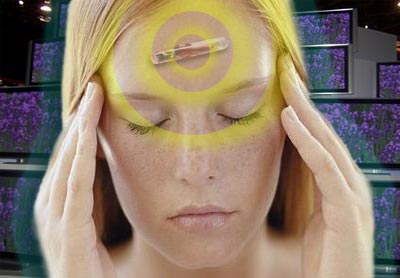The 'telepathy' chip, turn on the TV using the power of thought
Source: noonehastodietomorrow.com

A ‘telepathy’ chip that allows people to control computers, televisions and light switches by the power of thought is being developed by British scientists.
The tiny sensor would sit on the surface of the brain, picking up the electrical activity of nerve cells and passing the signal wirelessly to a receiver on the skull.
The signal would then be used to control a cursor on a computer screen, operate electronic gadgets or steer an electric wheelchair.
The chip is the brainchild of Dr Jon Spratley, 28, from Stevenage, Hertfordshire, who developed a prototype during his PhD at Birmingham University.
'We are just trying to help people with severe communication problems or motor neurone disease - like Dr Stephen Hawking or Christopher Reeve,' he said.
'What we have designed would allow them to control a computer with their thoughts. If they imagine their muscles moving, that could flick a light switch for example.
'It's an area that is being heavily researched in America but so far all the tests have involved wired sensors. This prototype uses wireless technology to remove the risk of infection and that's the real drive of our work.
'The eventual aim would be to see these systems fully working so they are available to help patients communicate. That's the future.'
The 1.3mm 'multi-contact brain probe' has yet to be tested on a living person or animal. However, tests on brain slices in a laboratory have been promising.
Earlier this year, Japanese researchers unveiled a wheelchair powered by brainwaves. The user wears a cap fitted with electrodes that monitor brain activity.
Scientists have also developed a robotic arm controlled by thought. In tests, monkeys were able to feed themselves using the mechanical limb.
Dr Spratley's invention is a tiny sensor designed to be injected by needle into the brain. The chip has 50 'contact spikes' that connect to nerve cells in the brain.
As the needle is withdrawn, four coil antennae - each just 1mm across - are unfurled on the surface of the brain. These communicate wirelessly with a 'base station' - a 16mm diameter receiver that is permanently placed in the hole left by the needle.
The device picks up neural signals from the brain's motor cortex and transmits the impulses via the base station to a receiver connected to a computer.
Dr Spratley said just seven unique 'thought commands' are needed to provide mouse-like controls for a computer.
He believes implanting the chips will require minimal invasive surgery - yet could change the life of a quadriplegic or motor neurone disease sufferer.
'It began as an investigation into what signals paralysed people can generate,' he said.
'If they can imagine using a limb, even if they can't move it, you can tap into that signal.
'Then you just have to imagine moving the muscle and the leg will move, the brain will train itself.
'Stephen Hawking could just think about using his muscles to operate his machine, rather than have to move his cheek.
'And yes, it would have worked for Christopher Reeve. Muscle control comes back.
'My work was only ever going to be the tip of the iceberg and I hope eventually it will help people. I am glad they are taking it forward.'
Previous chips have relied on cables and wires to send brain signals from a sensor to a controller outside the body.
Dr Spratley, who now works for Cambridgeshire-based company 42Technology, says the wireless chip is safer.
He is now looking for funding to start human trials.
Article from:
Red Ice Creations Radio - William Henry - Stargate Technology & Transhumanism (Subscription)
Red Ice Creations Radio - Aaron Franz - The Age of Transitions
Red Ice Creations Radio - Aaron Franz - The Age of Transitions Continued (Subscription)
Red Ice Creations Radio - Michael Tsarion - The Post Human World






















